Come January 2019, Alvaro Morata was a Chelsea reject who the London club simply could not wait to get rid of. Now, back in the colours of his boyhood club Atletico Madrid, he has returned to the Morata that convinced the Blues to fork out £60 million for his services.
Our tactical analysis will provide insight into how the Spaniard has performed on loan in La Liga, rediscovering his best form.
In a front two
Quickly establishing himself ahead of injury-hit Diego Costa in the pecking order, Morata is no longer a lone centre-forward as he was at both Chelsea and Real Madrid. Instead, he lines up alongside Antoine Griezmann in a front two. It’s a role which has suited him well, allowing him to capitalise on his intelligence and movement to exploit the spaces left behind when defenders are attracted to his French teammate.
Much like at Real Madrid where defenders would crowd around Cristiano Ronaldo and Morata would pick up the slack in behind, Morata is taking advantage of not being the focal point in attack. While at Chelsea he would often cut an isolated figure and carry the weight of the team in the final third, it is clear that he is benefitting from this set-up allowing him to share the responsibility and handle less defensive pressure.
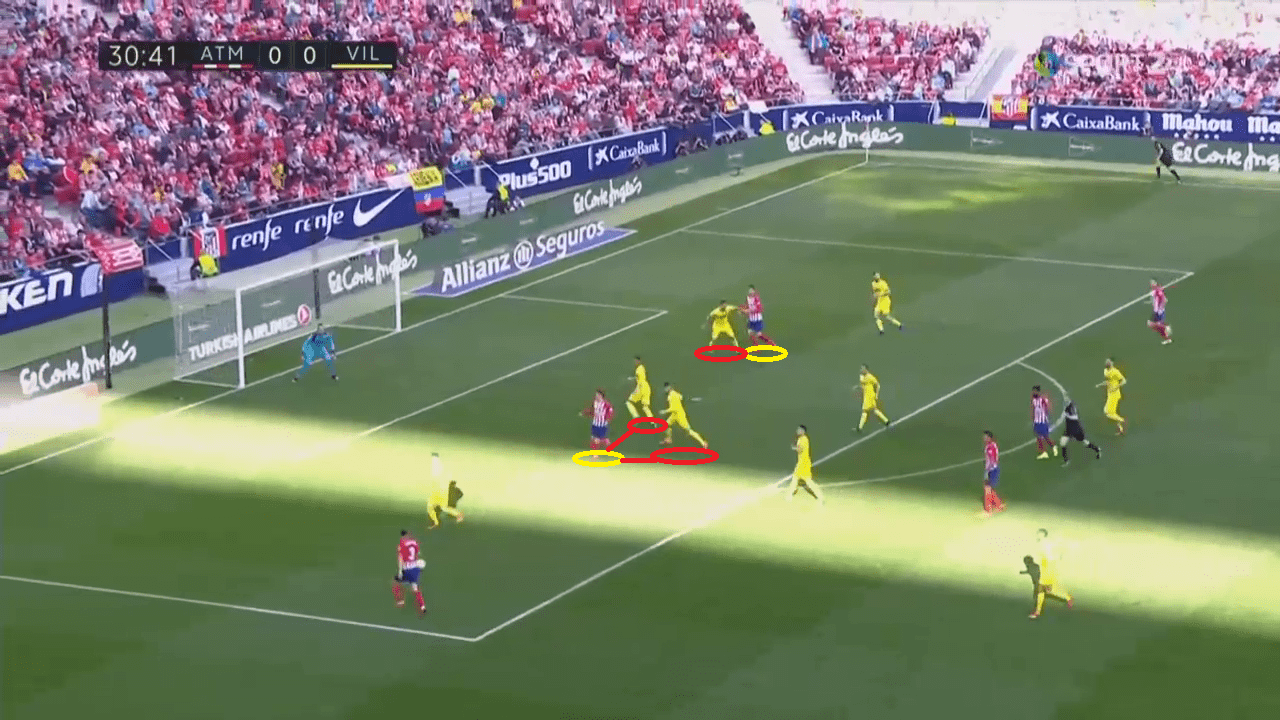
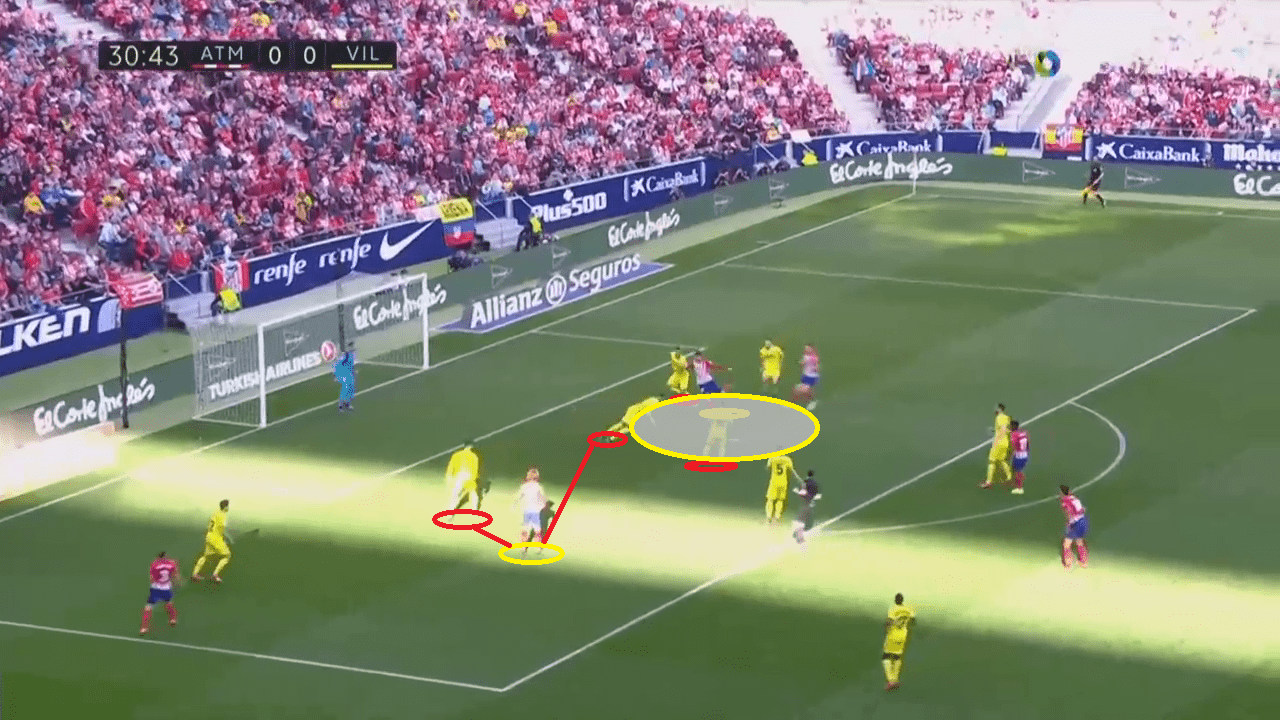
His first goal against Villarreal came through that exact approach, with Griezmann pulling two men towards the ball, creating space in behind for Morata to step away from his man and apply a fine volley into the bottom corner. Having had two goals ruled out by VAR in the past week, Morata showed the kind of composure that would be expected of an elite striker and did not allow the frustration to get to him. Unlike his tantrums and strops at Chelsea, his mindset appears different when he is not his team’s talisman.
No longer the last man
That also has a clear impact on his positioning on the field. Less and less, Morata is clinging onto the last man and hanging around in the danger areas. Instead, he shares this role with Griezmann and can often be found deeper and wider, playing more of a role in the build-up and drifting wide. With Diego Simeone often deploying one non-attacking player in a wide midfield role, such as Koke or Saul Niguez, it allows Morata more space to occupy those wide spaces that he simply did not have at Chelsea where wingers need that space to bomb into.
This provides flexibility to Morata’s approach. He is no longer tied into the same sense of being the man that all passes should be aimed at once they enter the final third. Whilst he still excels most when entering the box and looking to pick up on a chance, he is improving his all-round game and is picking and choosing his moments to enter the box with a more clinical approach.
It’s one that is working well and getting results. It can be seen in his shot accuracy, which has soared from 45.1% with Chelsea to 61.4% with Atletico, alongside a decrease in average shots per game from 3 to 2.5.
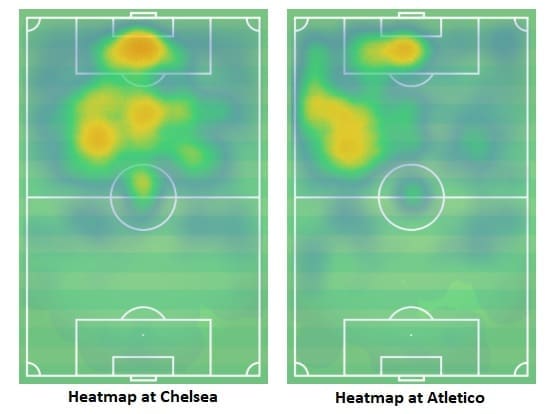
Another difference is that he has occasionally been used, albeit rarely, in a front three. Simeone’s experiment against Athletic Club was more of a damp squib than an attacking explosion, but it did invite Morata to play in a deeper and wider role than he is accustomed to. That may take some more getting used to for Morata, having never previously played in such a wide role, but it could be an intriguing way of monitoring how he progresses under Simeone.
Aerial power
As part of his partnership with Griezmann and in his new role, he has also played as a different kind of striker. Rather than simply being the man to apply the finishing touch or get on the end of crosses, he has become more involved in the team’s hold-up play. It must be remembered that Diego Simeone’s team play with a much more direct approach than Maurizio Sarri’s, but Morata’s aerial duel success rate has increased by 50%, going from 32% in blue to 48% in red and white.
Particularly with Costa out injured at one point, Morata became the key man in hold-up play and inviting others into the game. Griezmann tends to drop deeper to transition from defence to attack. This allows the long ball to Morata to hold up as Griezmann catches up to become a regular aspect of Atletico’s counter-attacking style.

Whilst at Stamford Bridge he would often be found trying to get on the end of crosses, his headers are of a different type at the Estadio Wanda Metropolitano. He has scored plenty of headers already, with a two-minute brace against Real Sociedad including two headers from set pieces.
It’s clear though that this is one element of his game which Simeone is looking to exploit and where he has a clear advantage over his La Liga counterparts. This in itself shows how Morata may be better suited to the Spanish style of football, given how he often struggled with the physicality of the Premier League.
Dynamic movement
However, that’s not to say that Morata’s play has become one dimensional: far from it. With the increased confidence, he showed just what he is capable of when given free reign in attack when playing for Spain, leading the way against Malta. Across his two outings for Spain in the March international break, he recorded a higher xG in both games than in any of his previous four appearances for his country, dating back to November 2017.
This movement remains a key element of his game and was one that was repressed at times in London. With growing confidence in his abilities, he is not afraid to take more gambles and make such runs. He is often seen at set pieces to be moving around in the six-yard box hoping for a knock-down or a deflection to fall his way. At Chelsea, he was too static, but that has rapidly become a thing of the past as he has settled into life back in his native Spain.
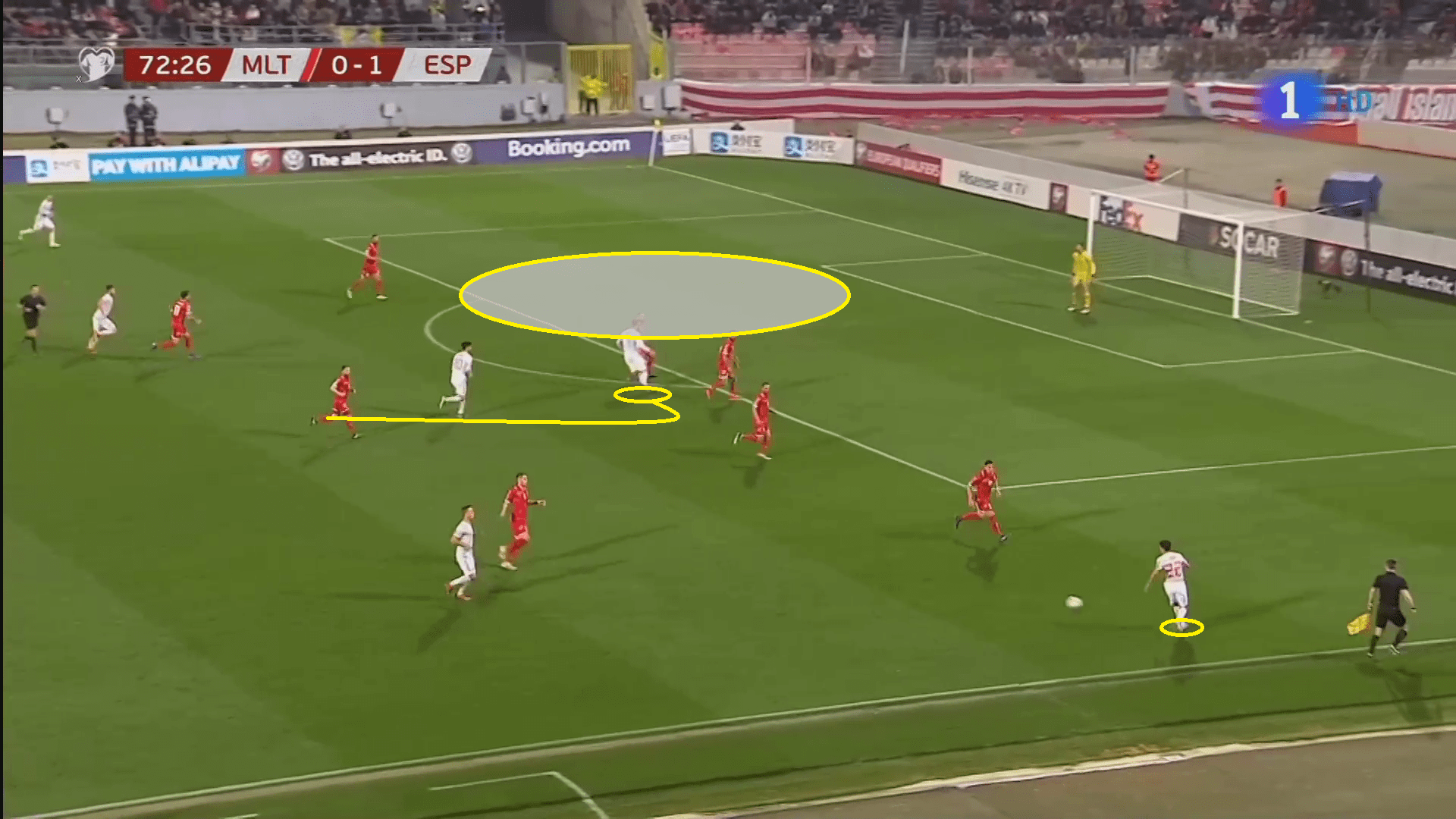
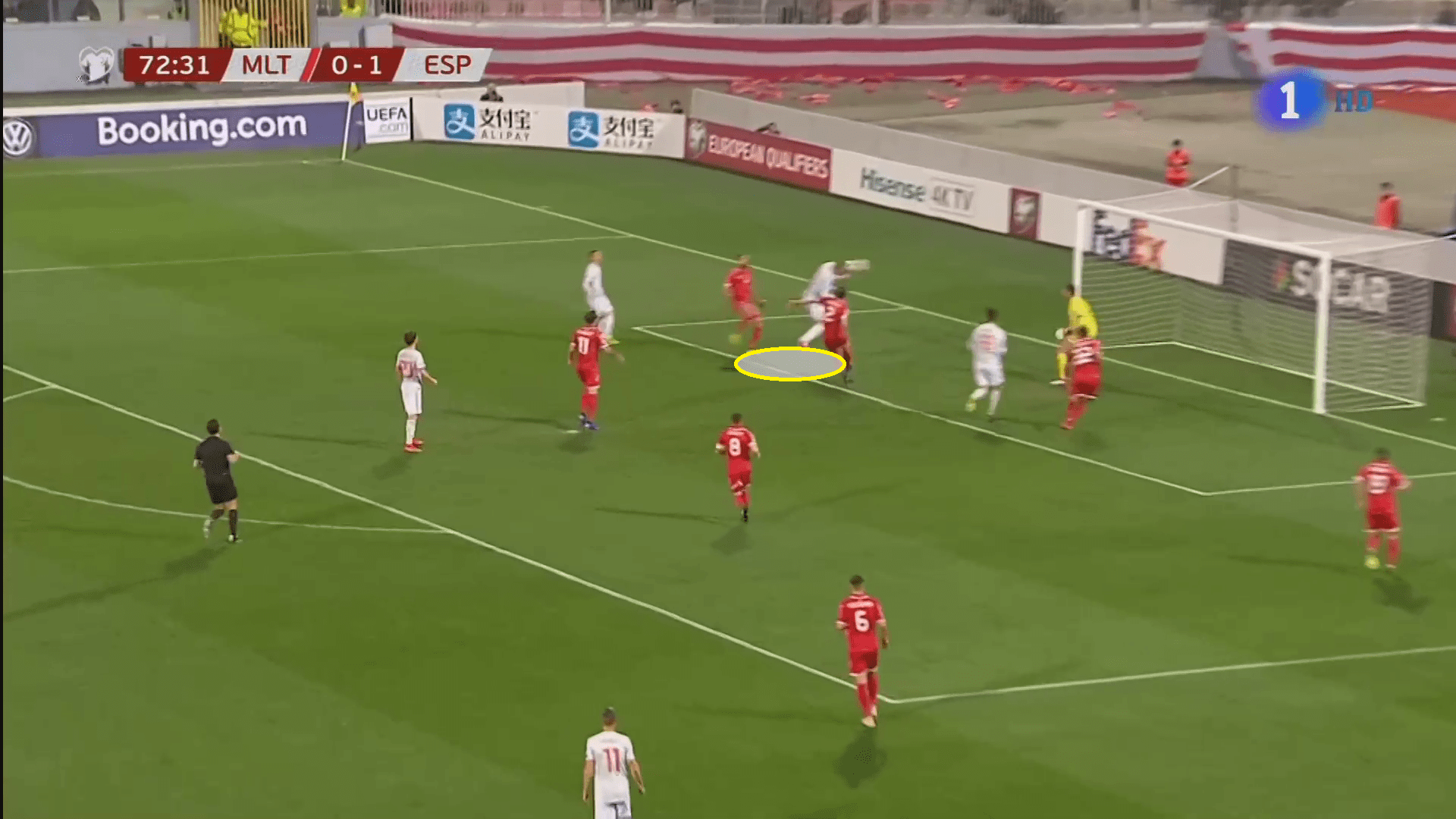
As Luis Enrique has made it clear that he wants to move away from the target-man style of Diego Costa that Julen Lopetegui preferred, calling up the likes of Iago Aspas, Rodrigo Moreno and Jaime Mata as his new strikers, Morata sees an opportunity. It’s an opportunity which presents a different style of play to that which is getting the most out of him at club level, but it is one that he is clearly keen to take up.
What’s next?
With another year left on Morata’s loan deal in Madrid, the expectation will be that he continues to climb towards the kind of form that he showed at Juventus and Real Madrid in the past. If he does so, a permanent move looks inevitable, particularly as speculation mounts surrounding both of his attacking team-mates, Griezmann and Costa.
He will also be aiming to re-establish himself as first choice for his country. Enrique has given him the opportunity by recalling him and Morata has grasped it with both hands. He will need to maintain this form consistently in order to make the shirt his own, but he is certainly on the right track.
Morata has shown signs of why Chelsea signed him since he departed, yet it may not be a sign that the Blues should consider retaining him. Every element that is helping him to succeed is vastly different to the style deployed by the Blues, and confidence is playing a big factor. With Simeone’s more direct 4-4-2 approach, it is getting the most out of Morata in a way that Chelsea would never contemplate doing. For all parties, this move has been the perfect remedy.
If you love tactical analysis, then you’ll love the digital magazines from totalfootballanalysis.com – a guaranteed 100+ pages of pure tactical analysis covering topics from the Premier League, Serie A, La Liga, Bundesliga and many, many more. Buy your copy of the March issue for just ₤4.99 here, or even better sign up for a ₤50 annual membership (12 monthly issues plus the annual review) right here.

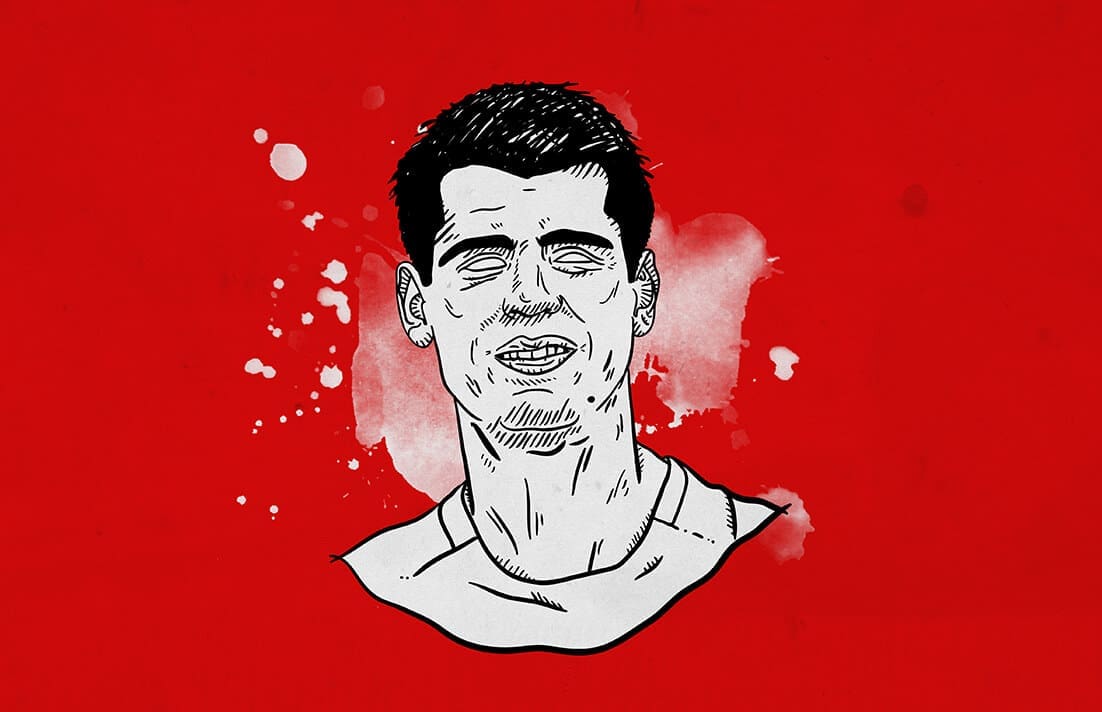



Comments